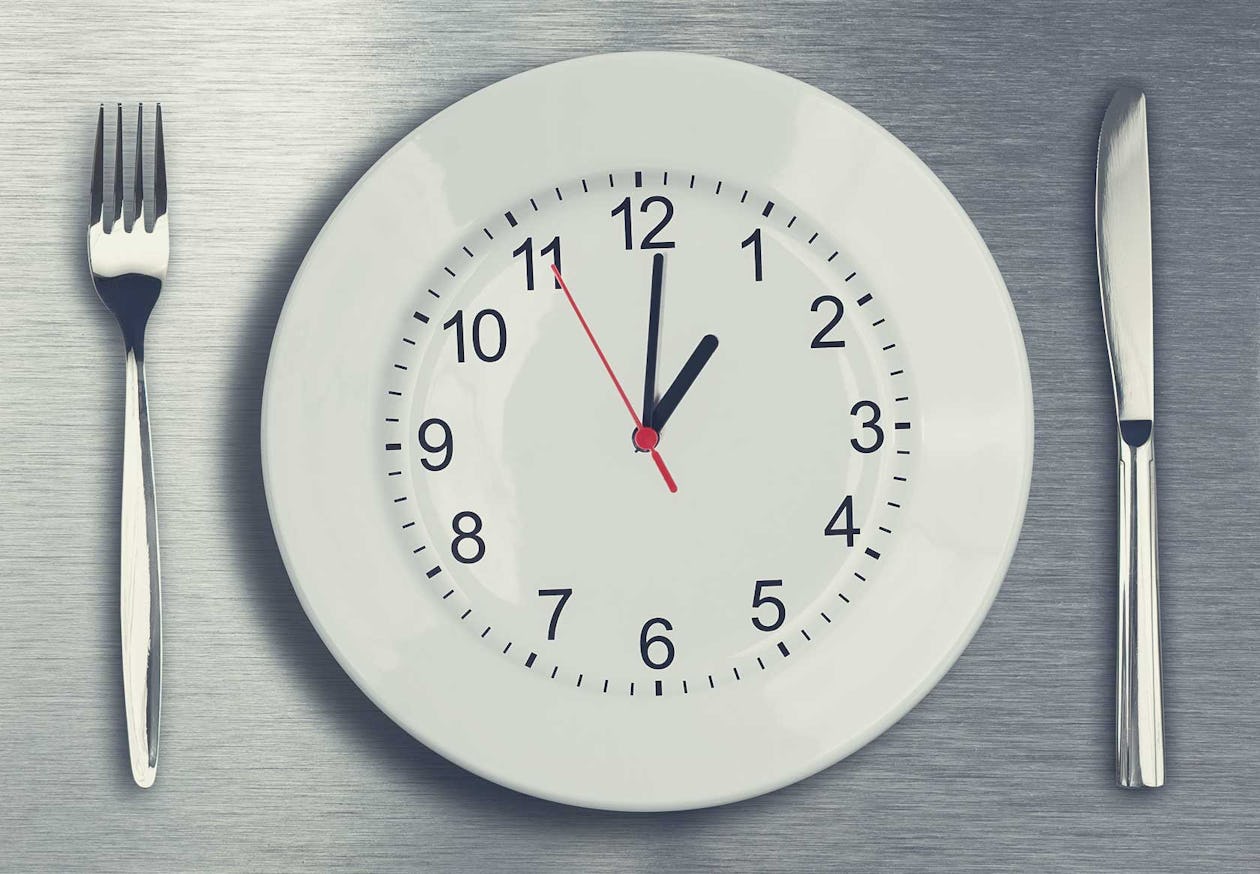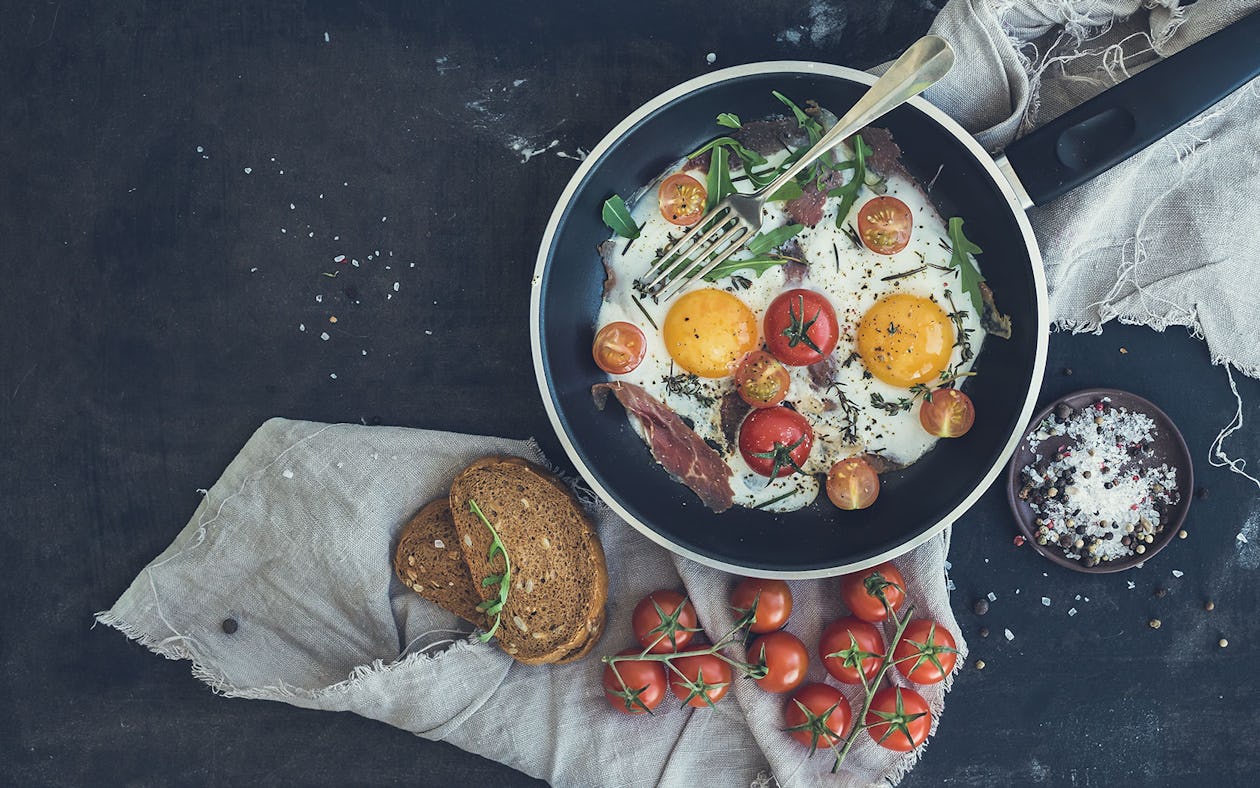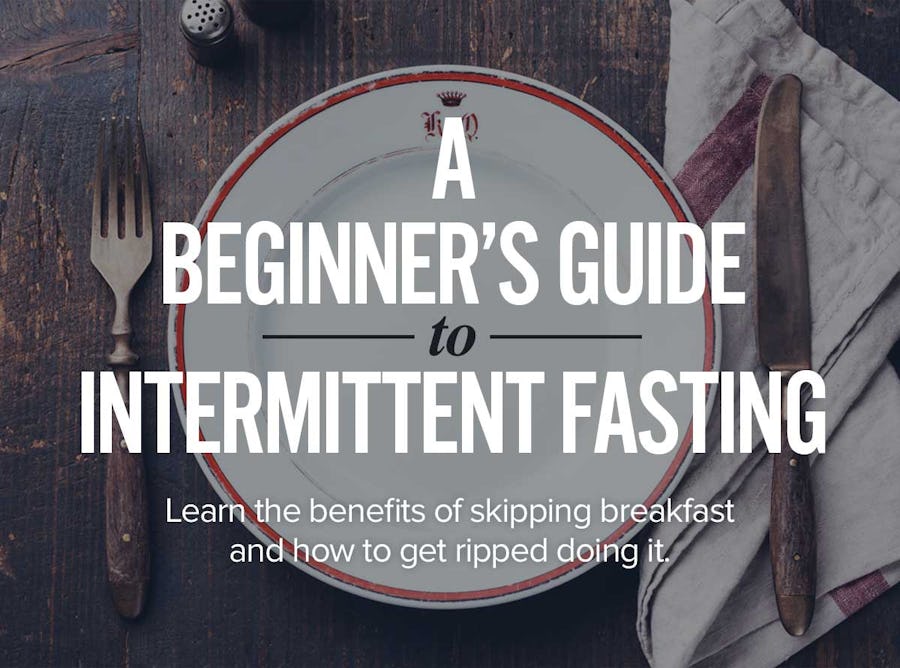INTERMITTENT FASTING may well be the most discussed dietary concept on the Internet right now. Like many other “breakout” diets, intermittent fasting (I.F.) is growing by leaps and bounds. However, unlike most other diets, I.F. is gaining ground despite challenging many long-held assumptions about nutrition.
In fact, practicing I.F forces you to eat in direct opposition to those assumptions, and that—along with the results—is what’s generating all the buzz. Before we get into the why and the how, let’s first discuss the basics of the what.
“Breakfast is the most important meal of the day. Eat as soon as you wake up to break the fast and set yourself up for healthy eating patterns.“
“Don’t skip meals, your body will think it’s starving and your metabolism will suffer.”
“To keep your metabolism revving, you should eat a mini meal every three hours.”
Most of us have spent the last 20 to 30 years believing these statements to be true. But what if I told you all of these common suppositions might be wrong? Or at least, might not be entirely right? The modern approach to meal consumption actually stands in stark contrast to more historical standards. This isn’t necessarily a bad thing, but the reality is, we just don’t know for sure.
While modern standards say we should eat three meals a day with snacks between meals, historically, this hasn’t been the norm. Light, ongoing grazing and a single, larger meal is actually more representative of the makeup of historical meal timing. So why, then, are we so convinced that skipping meals or failing to eat breakfast is “bad” for health and metabolism?
The easy answer is, “Well, research says so,” but that’s only sort of true. The field of nutritional research is still relatively new, and most studies leading to the commonly held beliefs that you shouldn’t skip meals or deny yourself breakfast don’t account for every contributing variable.
For instance, a large-scale epidemiological study that draws the correlation between skipping breakfast and weight gain may not consider factors such as high-stress jobs or the consumption of highly processed foods as co-factors to skipping breakfast.
Plus, common sense flies in the face of claims that skipping meals always negatively impacts metabolism. Just look around the leanest of individuals are typically calorie restrictive; They control how much they eat, sometimes skipping meals to do so.
As a society, we could certainly benefit from a little more self-control in the kitchen, and if diets are hard to maintain, maybe a well-employed fasting plan could kill two birds with one stone; providing calorie restriction without the overwhelming maintenance of a long-term diet.
That’s why the recent and growing research on the impact and benefits of intermittent fasting is so interesting. And for some people, it could be a real game changer.
What is Intermittent Fasting?

The most accurate definition is the simplest one: I.F. is merely alternating intervals of not eating (fasting) with times when you are allowed to eat. Or, to use I.F. parlance, you alternate a fasting period with a feeding window. How long each will be tends to vary heavily, depending on which intermittent fasting protocol you select—and there are several.
Each method of intermittent fasting will be discussed later in the article, but for now, it’s enough to mention that the differences come from expanding the fasting window. The fasting period on specific plans can range from 16 hours all the way up to 36 hours (with several stops in between), and each of those specific plans will have benefits.
It’s also important to note that every one of us does some form of fasting, whether you realize it or not. The least technical-while-still-being-accurate definition of fasting is simply “not eating,” so anytime you’re not eating, you’re fasting. Most of us aren’t on a structured timetable of meals where the window of fasting is constant, so rather than fasting intermittently, we’re fasting haphazardly—and there’s no benefit there.
The exception for most people is sleep. When you’re sleeping, you’re fasting; therefore most of us have a fairly rigid fasting period of 6 to 8 hours per night, until we eat in the morning. It is for this reason, by the way, that our morning meal is called “breakfast,” as you are literally breaking your overnight fast.
I want to be very clear that intermittent fasting (I.F.) isn’t even remotely the same thing as anorexia. Specifically, intermittent fasting is, by nature, intermittent. In other words, it’s done for brief, controlled periods of time. Some of the best examples of intermittent fasting are those associated with religious practices.
For instance, the 4-week period of Ramadan during which practicing Muslims don’t eat or drink from sunrise to sunset. They’re welcome to eat during the night, and some even eat to excess, but during the day, an intermittent fast is in effect. Anorexia, by contrast, is sustained and extreme caloric restriction with the sole intent of fast and extreme fat loss.
The Most Important Meal of the Day? Should You Skip Breakfast For Faster Fat Loss?
When I was a kid, my parents would rush me to eat breakfast before going off to school. My parents believed that eating breakfast was vital and the only way to ensure I had enough energy to be productive at school. Were my parents the only ones who valued breakfast? Of course not!
When you wake, your body is in a fasted state. Assuming that your goal is to reduce fat, eating breakfast early morning theoretically stops fat loss or “breaks your fast”. In fact, breakfast is such an important part of everyone’s life that we make it a priority to eat first thing in the morning. We subconsciously hurry to eat breakfast before going to work, school, exercise at the gym or go off into the day.
Why?
Well, somewhere down the road we were taught to believe that breakfast is the “most important meal of day” and skipping it would crash your metabolism, drop your blood sugar to unhealthy levels, and that your body would cannibalize itself, go into starvation mode, and affect your thyroid health. YIKES!
Is this true? Will skipping breakfast slow you down, decrease energy, and work production?
Absolutely not!
The Truth About Eating Breakfast

Breakfast is sort of a hot topic in the Intermittent Fasting world, and in fact seems to be the first point of contention for people looking in on intermittent fasting from the outside. Don’t we need breakfast? Intermittent Fasting proponents tend to say no¦which flies in the face of much of the dietary advice coming from every authority from Registered Dietitians to MDs. I.F. peeps don’t give a shit, though, because these dudes hate breakfast.
Here’s why: for years, we’ve been told that breakfast is the most important meal of the day. In fact, many people are often scolded by their physicians for skipping breakfast—particularly people who are embarking on a plan to lose weight.
There is some credence here, by the way: a study conducted in 2008 showed that participants who ate a calorically dense breakfast lost more weight than those who didn’t. The espoused theory for the results was that the higher caloric intake early in the day led people to snack less often and lowered caloric intake overall.
The value of that study has been questioned for many reasons, not the least of which is that despite the fact that roughly 90% of Americans eat breakfast, close to 50% of Americans are overweight. If eating breakfast is the first step to weight loss, then clearly something else is going wrong.
More evidence seems to support the breakfast idea, though. There are some epidemiological studies that show a connection between skipping breakfast and higher body weight. Of course, proponents of the breakfast theory are quick to suggest that most people are simply eating the wrong breakfast, as quick n easy meals like Danishes and doughnuts, which can lead to weight gain.
However, the crux of the breakfast study is ultimately that a larger breakfast leads to a lower daily caloric intake. That is, the argument for a larger breakfast ultimately boils down to energy balance; if that study is reliant on the position that weight loss comes down to calories-in versus calories-out, then the make up of the food shouldn’t matter. If we’ve learned anything from Mark Haub’s Twinkie Diet, it’s that you can eat garbage and lose weight. Clearly, something else is going on.
The only real argument that breakfast crowds have is insulin sensitivity. On a very basic note, the more sensitive your body is to insulin, the more likely you are to lose fat and gain muscle. Increasing insulin sensitivity almost always leads to more efficient dieting.
Getting back to it, supporters of eating breakfast declare that as insulin sensitivity is higher in the morning, eating a carbohydrate rich breakfast is going to have the greatest balance of taking in a large amount of energy without the danger of weight gain.
This brings us back to I.F.. You see, insulin sensitivity isn’t higher in the morning; it’s higher after the 8 to 10 hour fasting periods you experience if you sleep. Or more specifically, insulin sensitivity is higher when glycogen levels are depleted; liver glycogen will be somewhat depleted from your sleeping fast.
Intermittent fasting takes that a step further. It seems that extending the fasting period beyond that 8 to 10 hours by skipping breakfast (and therefore further depleting glycogen) will increase insulin sensitivity even further.
Insulin sensitivity is also increased post-exercise due to further glycogen depletion in addition to other mechanisms, I feel it makes to most sense to compound benefits by training in a fasted state, then having a carbohydrate meal or shake, maximizing the already potent effect of your para-workout nutrition.
Ultimately, this all means that there’s nothing special about breakfast and first thing in the morning—the first meal you eat to break your fast will be exposed to the benefits of increased insulin sensitivity.
On the other hand, I’ll take my tongue out of my cheek long enough to say that there’s nothing inherently evil about breakfast either. Even if you practice some form of fasting, you can still eat breakfast. Remember, the more important part is the length of the fast, not the time of the fast. Skipping breakfast just happens to be the easiest way to implement a fast.
A discussion that mentions skipping breakfast—or any meal, really—will invariably lead into a discussion of meal frequency, which leads me to my next point.
Frequency of Intermittent Fasting?

It seems that over the past 15 to 20 years, hundreds of diet books have been printed, and no two were identical. In fact, some of them have been in direct opposition to one another.
Calorie-restrictive plans like Weight Watchers certainly don’t agree with plans like the Atkins diet, the first iteration of which allowed dieters to at all they want, as long as they kept carbs low. Similarly, carb conscious plans generally call for products like yogurt or cottage cheese to be used as portable sources of protein, but many plans to reject dairy products altogether.
Despite the incredibly disparate natures of so many of these diets, the one thing that has been consistently suggested in most books published over the past 20 years is the frequency of meals.
If you’ve read a diet book, seen a nutritionist or hired a personal trainer at any point during that time, you’ve probably been told that in order to lose weight, you need to eat 5-6 small meals per day. (Note: this suggestion is sometimes phrased as “3 meals and 2 snacks.”)
This style of eating, commonly referred to as the frequent feeding model, is popular with everyone from dietitians to bodybuilders, and has been repeated so often for so long that it’s generally taken as fact. Which it isn’t. In fact, the reputed benefits of eating small meals more often have never been scientifically validated.
The first and most commonly cited of these is that eating frequently “stokes the metabolic fire.” Put less colloquially, the theory suggests because eating increases your metabolic rate, then the more often you eat, the more your metabolic rate will be elevated. That’s true, but it doesn’t lead to more fat loss—in fact, it’s been scientifically borne out that there won’t be a difference at all.
When you eat, your metabolic rate increased because of the energy required to break down the food you’ve taken in. This is called the Thermic Effect of Food, or TEF. So, while you’re experiencing energy expenditure due to TEF every time you eat, the net effect is no different regardless of how many times you eat, as long as the total amount of food is the same.
You see, TEF is directly proportional to caloric intake, and if caloric intake is the same at the end of the day, there will be no metabolic difference between eating 5 to 6 meals or 2 to 3. In fact, as long as the total calories are the same, you can eat ten meals or one meal, and you’ll still get the same metabolic effect.
Further, one study has shown that eating more frequently is less beneficial from the perspective of satiety, or feeling “full.” Which means that the more often you eat, the more likely you are to be hungry—leading to higher caloric intake and eventual weight gain.
Intermittent Fasting guru Martin Berkhan has summarized this study, its meaning, and the effects of such things quite well, but suffice it to say that it seems people who eat larger meals less frequently take in fewer calories and are more satisfied doing so.
A smaller number of meals obviously fits well into fasting protocols—if you are condensing the amount of time you’re “allowed” to eat into a small window of 4 to 8 hours, having more than 2 to 3 meals becomes impractical at best and impossible at worst. My clients who practice I.F. eat 3 meals (not counting a post-workout shake, which they consume on days they train with weights).
What Research Says About Intermittent Fasting

For the record, I am not suggesting that going ahead with intermittent fasting and skipping breakfast is the “ONLY WAY” to lose fat because obviously there are other diets and trategies to nutrition that have proven results, but I am simply introducing another perspective. And I would argue that skipping breakfast makes a little more sense metabolically. But wait! I know what you are thinking, is this strategy only beneficial for losing fat? Not at all. In fact there are many additional health benefits.
The research on intermittent fasting is overwhelmingly positive, and not just from a fat loss perspective. A few recent studies have found I.F. could help:
â Reduce risk of coronary artery disease and diabetes, as well as employ significant, positive changes to blood cholesterol in healthy and pre-diabetic populations.
â Improve markers of longevity that could contribute to a longer lifespan.
â Benefit children with severe epilepsy, reducing seizures beyond the reductions seen using a ketogenic diet alone.
â Override the harmful effects of a high fat diet by preventing obesity and liver disease.
â Improve brain health and help stave off Alzheimer’s Disease.
â Protect cells, slow tumor growth and reduce side effects of chemotherapy treatment in cancer patients.
â Give the stomach and pancreas a break from constantly secreting digestive juices (Hydrochloric acid and bicarbonate). Both aid in killing bacteria, mashing food particles, and neutralizing gut pH. The result is a healthier flow of juices and movement of food from point A to B.
â Give the pancreas an opportunity to recharge from secreting digestive enzymes and hormones. This rest aids in optimal enzyme secretion, food break down, and improved blood sugar regulation.
â Aid in “re-sensitizing” cells in utilizing glucose. In other words, cells become more efficient at using glucose (carbs, sugar) and converting it into potential energy.
â Improve hunger control. Most people eat immediately once they hear or feel their stomach growling. Skipping breakfast will help control or reduce your hunger. Thus you only eat when your body is truly craving nutrition.
In other words, I.F. is pretty amazing. Researchers are still trying to find out why it’s so amazing, but they’re starting to hone in on a few contributing factors. For instance, a 2015 study performed at the Yale School of Medicine determined that fasting stimulates the release of the compound beta-hydroxybutyrate (BHB).
BHB directly inhibits the inflammasome protein complex, which drives the inflammatory response in disorders including autoimmune diseases, Type 2 diabetes, Alzheimer’s disease, atherosclerosis and autoinflammatory disorders. In other words, inflammation is a known body-wrecker, and fasting can help prevent the inflammatory response and its associated diseases.
Just be aware that many of the studies performed to date have been on mice and other animals. There have been fewer human studies, so definitive benefits for human population are less clear.
Obviously, above and beyond the debunking of long-believed myths, there are numerous benefits to Intermittent Fasting that make it so popular.
As we’ve established thus far, people who practice I.F. eat less frequently. In addition to feeling hungry less often and more full when they do eat, these people benefit in terms of practicality and logistics.
After all, eating fewer meals means fewer meals and buying fewer meals. In addition to saving you time (and probably money), this also means that you’re exposed to flavors less often, and are therefore less likely to get bored and eat something you shouldn’t.
We’ve also mentioned that eating less frequently tends to result in eating fewer calories overall, but that’s a pretty important point so it bears repeating: eating less frequently tends to result in eating few calories overall.
And speaking of caloric restriction: that brings us to another benefit. I.F. plans that require full-day fasting drastically reduce your calorie intake, so if you are using a style of I.F. which requires you to fast for 24 hours twice per week, you’re reducing your food intake by about 30%. It’s not hard to see how that would lead to weight loss.
Going a little further, by restricting calories, you’re forcing the body to look elsewhere than the gut for energy, which can encourage cellular repair. That is, a cell will turn to its own damaged proteins for energy.
While that cycle would be bad in the long term, keep in mind you’re only fasting for “brief” periods. When you eat again the cell will use the new cell-stuff to replace the old cell-stuff that’s been consumed.
All told, this phenomenon—which again, stems from caloric restriction—can generally help slow both disease and the aging process.
For something more specific: one study out of the University of Utah showed that people who fasted just one day per month were 40% less likely to suffer from clogged arteries.
While there’s certainly a lot to be said for caloric restriction, it’s important to keep in mind that intermittent fasting isn’t just about eating fewer calories—there are also hormonal benefits that lead to improved body composition.
For starters, there’s the improved insulin sensitivity that comes with fasting, especially when paired with exercises, as we’ve covered. However, fasting has other hormonal benefits, including (but not limited to) an increase in the secretion of growth hormone (GH).
Growth Hormone has a myriad benefits—a full discussion of which is beyond the scope of this writing—but for our purposes it’s enough to say that the more GH you produce, the faster you can lose fat and gain muscle. Additionally, GH tends to offset the effects of cortisol, which is (in part) related to belly-fat storage. So it seems likely that fasting can help you lose belly-fat, at least indirectly.
Still not satisfied? Well, if you need another benefit, fasting reduces inflammation, which can have implications for improved immunity and increased fat loss.
I cover most of this information in my intermittent fasting video here:
Types of Intermittent Fasting Protocols
As in all nutrition-related subjects, there are different approaches to I.F., none of which have been proclaimed the “outright winner” for fasting benefits.
This is in part because more research needs to be done, but also because everyone responds differently to nutritional interventions. In other words, outcomes can vary widely based on age, sex, activity level, underlying illnesses and weight.
Generally speaking, the most common approaches are:
â Feast/Fast
â 24 Hour Fast
â 20 Hour Fast (Warrior Diet)
â 16/8 Fast ( AKA Lean Gains)
Got it? Great. Let’s get going. And the top four intermittent fasting protocols are…
Feast/Fast

SUMMARY: The feast/fast model, which I’ve been using consistently for close to 8 years, is my own small contribution to the community of intermittent fasting protocols.
Some time during 2004, I noticed that while I was getting a ton of benefit from cheat days in terms of fat loss and mental reprieve, the digestive aftermath wasn’t pleasant. If I cheated on a Sunday, I would pay for it Monday by means of intestinal distress.
Not only would I be in the bathroom more than I wanted, but my stomach would hurt and eating was a huge chore.
I had come from the old-school bodybuilding mentality of, “if you fall off the wagon, get right back on, immediately.” The old way of thinking states that even if you had a cheat meal/cheat day, if you didn’t go back to your regularly scheduled meals, you’d do more harm than good.
In my case, this meant a bowl of oatmeal and several eggs first thing in the morning. After a night of eating pasta, ice cream, brownies and steak (yes, all at once), the last thing I wanted to do first thing in the morning was eat.
After some time, I discarded the bodybuilding “rules” and started pushing my first meal of the day back by a few hours¦then a few more. Eventually, I stopped eating altogether. And my results got even better.
I’ve written about this both here and here, so let’s move on.
BENEFITS: When I started looking into fasting (mainly to justify my not-eating), I came across a few different reasons why the feast/fast worked so well; some had to do with fasting, obviously, but there was some stuff that had to do specifically with the cheat day as well.
Like any style of fasting, removing food for an extended period of time can lead to fat loss, because it often leads to lower caloric intake. Pretty simple. However, the reason this works well is because it’s coming on the heels of a cheat day. Again, I’ve written about this before, so I’ll be brief.
The abridged version: when you’re dieting, leptin-hormone controlling satiety- levels drop, which slows down fat loss. When you overfeed (cheat), leptin levels get bumped back up, increasing rate of fat loss. Therefore scheduling a period of fasting subsequent to a cheat day does two things:
1. Prevents any fat gain from the caloric spillover of eating, oh, I dunno, 14,000 calories worth of ice cream by creating an immediate deficit.
2. Elevated leptin levels from the cheat prevent stagnated fat loss, allowing the hormonal benefit from the fast (explained HERE) to proceed uninterrupted.
More than anything, this is just a practical approach and was created to alleviate discomfort. I started using this method before looking into science of any kind; it just happened to work.
DRAWBACKS:There are a few here.
First, in order for this to be applicable, you have to have a cheat day—can’t exactly do a feast/fast without the feast. Some people don’t like cheat days (I know, weird, right?). I made a pretty compelling argument for the inclusion of cheat days here, but if you don’t like them, you don’t have to use them.
From there, the main drawback is that you’re really looking at a 32 to 36-hour fasting period. If your last meal on your cheat day is before bed (assume 10 p.m.) on Sunday, and you don’t eat at all on Monday, your first meal is breakfast Tuesday morning. For a number of people, this has proved to be a pretty difficult thing to do.
I believe that with some practice just about anyone can abstain from food for an extended period of time with little discomfort, but for a lot of people, the idea of going without food for a day and a half is a bleak proposition.
For these people, I let them keep the training wheels on for a few weeks, allowing a small dinner on Monday night to take the edge off of the hunger. This won’t detract from any of the hormonal stuff, it just adds in some calories where there weren’t any before.
HOW (AND WHEN) TO USE FEAST/FAST: I am a big fan of cheat days, so I use this method nearly every week. I like my cheat days to coincide with Sundays—because, call me crazy, but I like wings and nachos when I watch football.
This means that Mondays, I don’t eat AT ALL. I think this is a good fit for most people – Monday happens to be the busiest day for most people, and so if ever there was a time where it helped to free up a few hours by not eating, this is it. Also, since people are busier, they tend not to realize they’re hungry. Overall, this is a fantastic combo that works very well for most people.
OVERALL IMPRESSIONS: Again, this is my method, so I can’t really be objective here, but it’s worked well for me in the past and all of my clients who have tried it.
24-Hour Fast (aka Eat-Stop-Eat)

SUMMARY: A 24-hour fasting period is essentially what it sounds like: if your last meal is at 8pm on Monday, then you do not eat again (at all) until Tuesday at 8pm. This can be done 1 to 3 times per week; two being the most common iteration.
It’s impossible to talk about 24-Hour fasts without talking about Brad Pilon and his book “Eat-Stop-Eat”, which is the definitive book on this style of fasting. ESE has been around for several years, but Brad continues to publish updated versions with more science whenever he can. It’s a well-researched book that also happens to be well-written.
Brad was one of the first people talking about I.F., and his approach is one of “lifestyle, not diet.” Brad discussed much of this in an interview I did with him, which you can read here.
BENEFITS: The 24-hour fast works well for a number of reasons. Firstit is easily adaptable to any lifestyle, and it’s very hard to screw up. The only rule is don’t eat for 24 hours. As mentioned above, this is much easier than a 36 hour fast, especially for those new to it.
Secondly, like most methods of fasting, the abstinence from caloric intake for large periods of time is going to be a large part of the reason for success. For example, if you generally eat 2,000 calories every day, that’s 14,000 calories over the course of a week.
If you remove two of those days, you’re eating 4,000 calories less. Without any other changes to your lifestyle, you’d be on pace for over one pound of fat per week. Even if you compensate and eat a little more on the days you’re not fasting, you are still going to wind up with a fairly substantial caloric deficit. Add in some exercise, and it’s not hard to see consistent weight loss.
Caloric manipulation aside, this style of fasting works incredibly well because of the effect that fasting has on your overall hormonal environment. More specifically, when we talk about fasting, we’re really going to talk about two hormones: insulin and growth hormone.
With regard to insulin, it seems the less often you eat, the less often you raise insulin levels. This is not surprising, obviously. It’s even less surprising that this would lead to fat loss, since we know that chronically elevated insulin levels make it very difficult to lose fat.
Therefore, if you’re eating less often, you’re going to have fewer insulin issues—even if you’re eating the same foods in the same amounts. (This, is a pretty strong argument against the popular frequent feeding method of 5 to 6 meals per day.) However, while fasting and infrequent feeding helps to control insulin and keep it low, that’s not enough to stimulate fat loss¦unless growth hormone is present.
If insulin AND growth hormone are both low, there isn’t a huge effect on fat loss. And so, while insulin management is important, growth hormone management is even more important. Which brings us to the very predictable point: The effect of fasting on growth hormone is incredibly important.
Your body releases GH pretty consistently, but research has shown increased secretion of growth hormone in three specific instances:
â During/immediately after sleep
â After exercise (as little as 10 minutes)
â During and immediately after a fast
Looking at these three things—all of which are thoroughly discussed in Pilon’s Eat-Stop-Eat—it’s not hard to come up with a “best of all worlds” scenario. If you produce a lot of GH while sleeping, and you produce it while fasting, then the obvious combination is to continue fasting after you wake, allowing for prolonged GH secretion. From there, exercise will allow for increased production in addition to your prolonged secretion.
Overall, this maximizes both the presence of GH and its effect. In addition, the elevated GH in combination with the low insulin is a deadly one-two punch to your body fat.
Finally one of the main benefits of both this style of fasting and the book itself is the incredible flexibility of the program and the ease with which you can adapt it to your lifestyle—you can fast any day you like, and can move it around at will to suit your social life, which is important.
DRAWBACKS: There aren’t many here. The main problem that clients of mine seem have here is that 24 hours seems like a long time to go without food; however, this is not unique to 24-hour fasting. That said, there are some people who seem to have medical problems with abstaining from food for a significant length of time. In particular, people with low blood sugar seem to have an issue. If you are hypoglycemic, you may want to tread lightly.
The only other problem here would be for people who train on fast days and don’t want to miss out on post-workout nutrition. This can be alleviated by either moving your workout to the end of the fasting period, or simply scheduling your off days and fast days to coincide.
HOW (AND WHEN) TO USE 24-HOUR FASTS: This is a style of fasting I tend to use when I get very busy and have to train in the evenings. Also, I use this pretty much any day when I have to go out to a large social dinner and am not going to be watching my diet. For example, if I am going out on a Friday night, I might make my least meal Thursday at 8pm. Then, at dinner Friday, I’ll get to eat a lot of food, perhaps enjoy dessert, and be fine, even if I go out after and eat again.
OVERALL IMPRESSION: While this type of fasting is suitable for more than “damage control,” it works well for me in an occasional fashion. However, for many of my coaching clients, this is a sort of “every other day” approach that works well with them.
More than anything else, I frequently find myself referring people to Pilon’s book as a an IF primer, and a good resource for understanding a lot of the science behind why fasting works. Check out Brad’s site and book for more info.
20-Hour Fast (aka Warrior Diet)

SUMMARY: The Warrior Diet was the first type of structured fasting that I tried. I initially read about it in an interview with the author, Ori Hofmekler on T-Nation back in 1999. I tried the diet for the first time in 2002.
Simply, the diet is a 20-hour fast followed by a 4-hour feeding period. As the name implies this is inspired by the nutritional habits of the warriors of antiquity, who certainly weren’t in the habit of eating six meals per day.
Instead, warriors in cultures ranging from Roman centurions to the Spartan elite subsisted on one to two meals: a large meal in the evening and (sometimes) a small meal in the morning, according to the author. The diet itself is modeled after this type of eating schedule; however, it’s worth noting that this is often criticized for not being “true” IF.
While having a small breakfast and a large dinner will probably work for weight loss, there may only be 8 to 10 hours between them; some people posit, isn’t long enough to get the benefits of fasting.
Moreover, during the fasting part of the day, the diet allows for mild consumption—you’d be allowed to eat a few servings of raw fruits and vegetables and a few servings of protein (protein shakes included) if needed/wanted.
These are kept quite small. Having said that, some fasting purists understandably maintain that Warrior Dieting, is not fasting.
In practice, however, most people skip the small meal and simply have one large meal at the end of the day.
BENEFITS: Much like a 24-hour fast, a 20-hour fast allows you to reap the hormonal benefit of increased growth hormone. And, like all fasting, generally will result in fewer calories being consumed.
The benefit that is unique to this type of fasting is that you’re generally eating one large meal and, therefore, the make up of such a meal isn’t as important as you might think; as long as you get adequate protein, you can eat “junkier” foods and still do well.
Moreover, having only one meal makes life pretty simple, and less thinking means less screw-ups.
DRAWBACKS: On the flip side, we’re running into the issue of hunger, which isn’t unique to Warrior Dieting.
The main drawback in my experience comes from the meal itself—trying to get all of your calories in a single meal means that meal is, by necessity, quite large. So large, that eating it often leads to discomfort. This is why many people turn to less wholesome foods, getting in 2,000 calories of chicken, veggies and rice isn’t nearly as easy as getting in chicken wings and French fries.
OVERALL IMPRESSION: It’s a generally good dietary practice, and certainly easy to follow.
One criticism often made is that the points are anecdotal, with very little scientific evidence to support the arguments. While some I.F. authorities dismiss the Warrior Diet based on that, I feel it should be respectfully acknowledged given that it was the book that got people talking several years back.
Moreover, while the book does lack science, it’s truly an enjoyable read. The author has a very engaging writing style and adding to the fun is the fact that he was an editor for Penthouse.
16/8 Fasting (aka LeanGains)

SUMMARY: Popularized by Martin Berkhan, LeanGains or 16/8 is a style of I.F. where the fasting period is 16 hours, and the feeding window is shortened to 8 hours. During this time, users may eat as few meals as they like, with the most frequent iteration being three meals.
Designed specifically with training in mind and mean to to be used for such, the 16/8 method has specific post-workout suggestions and recommendations. In nearly all ways, it’s the most sophisticated form of intermittent fasting.
Berkhan is great in terms of showing his research, and his clients get excellent results.
BENEFITS: In addition to having all of the benefits inherent in other types of fasting, the 16/8 methods is a stand out because it offers an advanced level of hormonal management.
While something like 24-Hour Fasting or Alternate Day Fasting will give you these benefits, these methods are not for daily practice, whereas 16/8 is. This means that you are going to have a daily increase in GH, which leads to greater effects.
Moreover, daily practice means that you’re eating the same way every day; this means that you don’t experience ups and downs in hunger, as with some other forms of fasting. Put another way, some people experience difficulty with fasting for 24 to 36 hours because they do it infrequently; not an issue with daily practice.
There is also the benefit of hunger management. A number of studies have recently shown that larger, infrequent meals are better for increased satiety than small, frequent meals—so you’ll be fuller, longer.
DRAWBACKS: There are very few drawbacks to this style of I.F., and these mainly come from scheduling. You see, from everything I’ve seen and read, the LG protocol is MOST effective if the workout is performed in a fasted state, and the meal that breaks the fast is immediately consumed post workout.
For some, execution can become a little impractical. For most people, adhering to that simple rule forces them to shift the feeding window to inconvenient times. I find that most of my clients are able to workout either in the morning (roughly 6am, before work) or in the evening (6 p.m.), after work.
Given that we want to have a 16-hour fasting window that ends with the PWO meal and begins an 8-hour feeding window, you can see how either of those times present some issues. For example, let’s look at 6am. In order for this to work as your first meal, your last meal is going to be at 4 p.m. (allowing you to fast for 16 hours until your next feeding window).
Right off the bat, I see three (theoretical) problems arising here. This first is that having your last meal at 4pm can present some social issues, at least if you ever want to have dinner with your friends or family.
The second is that your feeding window is going to coincide almost minute for minute with your workday, making it difficult to eat your meals, let alone enjoy them. The third problem is that a good number of your fasting hours are after your feeding hours have ended. In my experience, clients who try to have ’cutoff’ time for eating aren’t successful.
That said, if you’re looking to try 16/8 and can only work out in the a.m., it’s certainly doable, just be aware of this going in. And, of course, this “problem” is really only applicable to certain people. Like any other style of eating, make it work for you—within the rules of the system.
HOW (AND WHEN) TO USE 16/8: This style of fasting fits very well with my life, because I work from home.
For me, it’s very easy to plan my meals and workouts around one another, and making last minute changes isn’t a problem. Most days of the week—usually Wednesday through Saturday—I do some form of 16/8.
I like to workout anywhere between 12 and 2 p.m., so I just judge my last meal the night before based on when I’m going to train the next day. Sometimes I’ll wind up with an 18 hour fast instead of 16, but, again, this is really no big deal.
OVERALL IMPRESSION: Of all intermittent fasting protocols, 16/8 is probably the most sophisticated, in terms of both intention and execution. While most fasting is effective mainly because it prevents you from eating, LeanGains is really about making your hormones your bitch. Which is awesome.
This style of I.F. is best for serious folks and those who are already lean. This is the ONLY style of I.F. that was designed specifically with fitness-oriented people in mind; therefore yields exceptional results for folks who train consistently.
It’s worth mentioning that Berkhan is one of the guys most responsible for the “I.F. movement,” and spent years arguing against ideas that many fitness pros (myself included) thought were “fact.”
All in all, he and Pilon are a big part of the reason guys who weren’t talking about I.F. last year are talking about it this year. So, while he didn’t invent I.F., I feel I should give him a wi-five. If you haven’t already, please check out his site here.
So, You Can Stop Stressing About the Most Important Meal of the Day.

The US government and mainstream media have created strong cognitive biases surrounding the importance of breakfast. Over the past 20 years, how many commercials have you heard that called it, “The most important meal of the day?” A lot. A lot of commercials with really happy people who are surrounded by cute, animated animals as they eat breakfast and expound upon its virtues.
Breakfast became my favorite meal of the day when I was younger – solely because I got a toy in my breakfast cereal.
Beyond mainstream media, we’ve had the government telling us that we’re at risk of heart disease and excess weight gain if we skip breakfast, but have no fear. The US Government released a brand new set of dietary guidelines stating that skipping breakfast is no longer considered a health hazard.
It’s a lot of flip-flopping, but they finally got it right, so you can let it go. Let go of the belief that skipping breakfast is a threat to your core identity, because not only is skipping breakfast not going to have any adverse health effects, there are a slew of reasons why you should skip it – starting with convenience.
Note: I’m omitting the most significant reason (in my opinion) which is the potential to help you burn a lot more fat, with a lot less effort, by allowing you to extend your fasting window.
As I mentioned above, there is research on both sides of the conversation, but just know that you will in no way start gaining weight due to your decision to start skipping breakfast.
If your still aren’t convinced on the benefits of I.F., here are 6 more reasons why you should make intermittent fasting part of your lifestyle.
1. Convenience
More meals equate to more time spent preparing to eat, as well as eating. I don’t know about you, but I have a lot of stuff I want to learn and accomplish in life, so if I can save time every day skipping the entire breakfast routine AND see an increase in fat loss, I’m going to do it.
2. Happier Brain
It’s something young people don’t think about often, but there’s a lot of research pointing to fasting as one of the best things you can do to avoid Parkinson’s and Alzheimer’s disease. Beyond the benefits in the future, fasting practices have shown cognitive benefits that can help you think more clearly.
This may sound counterintuitive if you’ve been eating breakfast for years, but after a few weeks of skipping it, you’ll notice an increased sense of clarity and focus when you’re in your fasted state.
3. Increased Productivity
The key to my creative space is a fasted morning and a double Americano. Talk about a flow state. Without having to worry about where your first meal’s coming from each morning, you get to jump into accomplishing things on your to-do list without interruption.
4. Who Wants to Live Forever?
There is a lot of research circulating around the idea that fasting during a portion of your day can lead to an increased lifespan. During periods of fasting, your body spends less energy digesting food and more energy repairing and regenerating new healthy cells.
5. For the Love of Money
This point really seems to piss people off for whatever reason, but it’s simple: buying one less meal a day means you’re spending less money.
6. The Truth About Hunger Pains
Most people don’t really know what real hunger feels like. Instead of waiting until hunger starts to really set in, we’ve been systematically trained to eat in the morning because it’s just what you do.
This type of forced eating does jump start your metabolism, but it also jump starts your ghrelin production. Gherkin is the hormone released to signal hunger. This means you’re going to feel much hungrier, for the rest of the day. Putting you at risk of eating more and potentially overeating throughout the day.
Getting into a routine where you skip breakfast teaches your body to understand what it feels like when you’re actually hungry, and on top of that, it allows you to feast when you get hungry instead of having to control your portions.
When I’m hungry, I don’t want to graze, I want to feast. This allows for that. If you can relate to this, you’re going to love removing breakfast from your daily routine. If you are ready to take the plunge, here are 11 ways to help you get started.
11 Ways to Start Intermittent Fasting Today

1. Know Thyself and Know Thy Challenges.
Intermittent fasting requires control and restriction during fasting periods. If you are prone to disordered eating or eating disorders, IF could act as a trigger for unhealthy behaviors. Be very careful about trying IF if you think you might use it as an excuse for ongoing or overly restrictive calorie consumption.
2. Keep Training.
The IF studies performed on humans in relation to body composition, muscle mass and athletic performance indicate that intermittent fasting produces the best results when done in conjunction with strength training.
You’re more likely to reduce body fat percentage and maintain or improve muscle mass when you exercise and fast together (although not necessarily on the same days).
3. Eat Well When You’re Not Fasting.
One of the big challenges of a fasting diet is the inclination to over-consume during non-fasting periods. While you don’t necessarily need to count calories or restrict food intake when you’re not fasting, you should prioritize eating healthy, whole foods.
If you counteract your fast with a day of overzealous bingeing on highly processed sugars, you may not see the changes or benefits associated with intermittent fasting.
4. Ease Your Way In.
Intermittent fasting, ultimately, is a lifestyle change. But there’s no reason you can’t give it a test run to see if it’s an approach you’re comfortable with.
Try a single, 24-hour fast to see how it feels, or follow a week of partial day fasting with an 8-hour eating window between 11am and 7pm or 12pm and 8pm. If you find the experience tolerable, consider following an ongoing plan.
5. Grit Not Grits.
This is a big one. Understand that unless you’re someone who never gets hungry early in the day, the first 3 to 6 weeks are going to suck. You’ll experience hunger pangs during this initial periods, and your main tool to get through it is going to be grit.
Consider it a personal challenge that you’re taking on. You’ll notice that as the weeks go by, your body will adapt and you’ll slowly begin to only experience hunger later in the day. Your body is incredibly intelligent.
As long as you give it the time to adapt, you’ll easily reset your homeostatic rhythm (the body’s natural rhythm) to eating later in the day.
6. Black Coffee Helps.
To get the benefits of skipping breakfast, you don’t need to skip out on your morning coffee. Coffee acts as an appetite suppressant and will make your morning a lot less difficult when you’re first getting started.
7. Stay Busy.
Take this newfound chunk of time and put it to good use; completely immerse yourself in something. That immersion and potential flow you enter is going to divert your attention away from any cravings you experience. This is more important than you may imagine. Don’t let yourself get bored. Stay engaged and use your mornings to complete your most energy-intensive tasks.
8. Hydrating Helps.
A lot of what we perceive to be hunger can actually be attributed to dehydration. Use this window of time where you’re not eating to get uber hydrated for the day. I recommend drinking half your bodyweight in ounces of water each day (at minimum). Try to get in as much water as possible during the a.m.
9. Accept That You’re Going to Be The Weird Friend.
And so fucking what? You’re working towards becoming the best version of yourself. Skipping breakfast is a minor choice that doesn’t affect anyone else. If someone has a problem with it and continues to express it, then it’s due to a deeper insecurity on their end, not yours.
10. Let Yourself Off the Hook.
From time to time, you might go out to brunch with friends, and you’re welcome to take a day every week or two to have breakfast and indulge your eggs benedict cravings. Diverging from the no breakfast club 10% of the time isn’t going to offset all the benefits you’re receiving from the others days of skipping breakfast.
11. Create Leverage.
I can list all the benefits to why skipping breakfast is going to make your life better, but at the end of the day, whether or not you’re successful in the first few weeks will come down to willpower. Humans are 10 times more likely to take action in order to avoid pain than to gain pleasure. It’s just how we’re hardwired.
Use this to your advantage; tell yourself that if you break your fast more than once a week, then something awful is going to happen. I use leverage for everything in my life when I want to create healthy habits and get rid of unhealthy ones.
I recommend you think of something that will motivate you substantially, be it an awful exercise or burning a stack of money, and use that as leverage to get yourself to follow through. Make yourself do 300 burpees or make a donation to a cause that you don’t support.
The Importance of a Morning Routine
If you are going to go forward with regular implementing intermittent fasting into your lifestyle, then I cannot stress the importance of having a consistent morning routine.
A few months back, I posted a picture to my Instagram account that featured a small piece of my morning routine: drinking a glass of warm water mixed with lime juice and a dash of sea salt. Outside of being tasty, it’s got a host of benefits.
Since then, I’ve been getting a lot of questions about both that particular concoction, any others I drink, and my morning routine in general.
I started writing it all out, but then I got lazy and stopped. And then I looked in the mirror and realized I was having an incredible hair day, so I should just go ahead and film a video.
So, that’s what I did.
Which is to say that I’ve got a content-rich video for you detailing exactly what I put in my body each and every morning to help me stay healthy, fit, and keep my hair looking thick and luxurious.
This is worth thinking about. Morning routines, that is; not my hair.
So, check it out:
Final Thoughts
If you still aren’t convinced intermittent fasting is right for your or are uncomfortable with skipping or pushing breakfast back, then I recommend you try it for yourself and see what happens.
Remember, your body has plenty of stored liver glycogen, roughly 75 to 100 grams or 300 to 400 calories worth of stored glucose (energy) if you truly need it. Not to mention you have plenty of additional fat that you will be burning regardless of your body composition, lean or fat. So don’t panic, if you decide to skip breakfast, you have plenty of fuel reserves to cover you.
Again, don’t think that you should never eat breakfast again, but rather use this as a strategy to help burn more fat. Like I mentioned earlier, most people these days are carrying extra fat and eating breakfast isn’t helping them lose it – especially if that breakfast involves traditional sugary breakfast foods. Skipping breakfast can help. You can skip breakfast twice a week, three times, or five days a week (five days a week is my goal). It keeps me in control, healthy, and fat off my body.
So slow down, holster your fork and burn some fat!
Also,
Onnit would like to thank John Romaniello, Laura Williams, Brandon Epstein, and Jon Celis for their contributions to putting this guide together.
And for the most popular questions regarding IF, check out this post covering Intermittent Fasting FAQs.
For more information on intermittent fasting and other great fitness tips check out the resources below:
1. Romanfitnesssystems.com
2.Jumpropedudes.com
3. GirlsGoneSporty.com
4. Absolutraining.com

)





